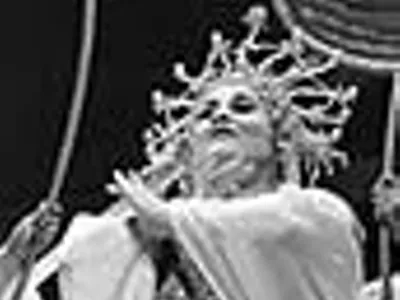
Audio By Carbonatix
[
{
"name": "GPT - Leaderboard - Inline - Content",
"component": "35519556",
"insertPoint": "5th",
"startingPoint": "3",
"requiredCountToDisplay": "3",
"maxInsertions": 100,
"adList": [
{
"adPreset": "LeaderboardInline"
}
]
}
]
Bleak is perhaps too cheery a word to describe Samuel Beckett's Endgame. Centered on the metaphor of a chess game's final phase, the playwright's most difficult work simultaneously addresses the power struggles inherent in all human relationships, the frustrations of the creative process, and the tedium and ultimate futility of life itself.
Written to be set in one bare room with two small windows, it is presumed that the play's four characters are the last people left on earth, survivors of what was likely a nuclear war. The University of Michigan Department of Theatre and Drama's production leads us directly to this conclusion with a subtle but unnecessary Fallout Shelter sign tucked into the set.
Set designer Kevin Judge has taken other liberties as well. The post-industrial confine, with its glass-peaked roof, bears a striking resemblance to the southeast portion of Henry Ford's near-abandoned Model T plant in Highland Park. Such contemporary touches, while clever, contravene the playwright's directions. Before his death in 1989, Beckett even sued a theater company that deigned to set this play in the New York subway.
The blind and paralyzed Hamm, the cornered king, occupies the center of the room, unable -- or at least unwilling -- to move without the assistance of his begrudgingly loyal minion (and perhaps adopted son) Clov. The monotony of the pair's existence -- Hamm's sole diversions are storytelling, pontificating and incessantly beckoning Clov from the tiny, barren kitchen where he passes the bulk of his eternal days -- is periodically broken by the emergence of Hamm's legless, elderly parents, Nagg and Nell, from the garbage cans where they have been stowed.
As directed by Philip Kerr and performed by four seniors in U of M's BFA program -- Josh Parrott as Hamm, Jason Lindner as Clov, Matt Oberg as Nagg and Kimberly Woodman as Nell -- the interaction between the characters is often captivating. This, unfortunately, is the production's biggest flaw. Seeming at times too much like senior BFA students, Parrott and Lindner are prone to overpowering the small Trueblood Theatre with BIG VOICES (Lindner never diverts from his) and BIG ACTIONS (Clov is forever thumping and banging about).
And Woodman's Nell is unforgivably cast as an insufferable Wendy Whiner -- a far cry from the weary, maimed elder called for in the script. Only Oberg, whose Nagg, interestingly, is often cast as the most absurd of the four, plays it relatively straight. As a result, his character is the most successful -- the only one who consistently conveys the sense of unbearable ennui Beckett intended, even as he delivers the play's funniest lines.
In his more subdued moments, however, Parrott is the most disarming of imperiled powermongers, pathetically projecting his inner torture onto his physical and emotional hostages, simply because there is nothing else to do as he waits -- and waits, and waits -- for the end to come. His and Lindner's timing is impeccable, vividly underscoring the dependency that underlies their characters' spite-ridden relationship.
Laudably, Kerr has chosen to portray Hamm not as an old man, but as young and, perhaps, once hip. With ski shades to hide his eyes and shorn, Michael Stipe-esque good looks, Parrott's youth is initially distracting. As the play wears on, however, that very quality becomes the play's most salient detail as the realization surfaces that life's tedium is not necessarily born of old age, but simply of existence at any stage in the seemingly endless game.





